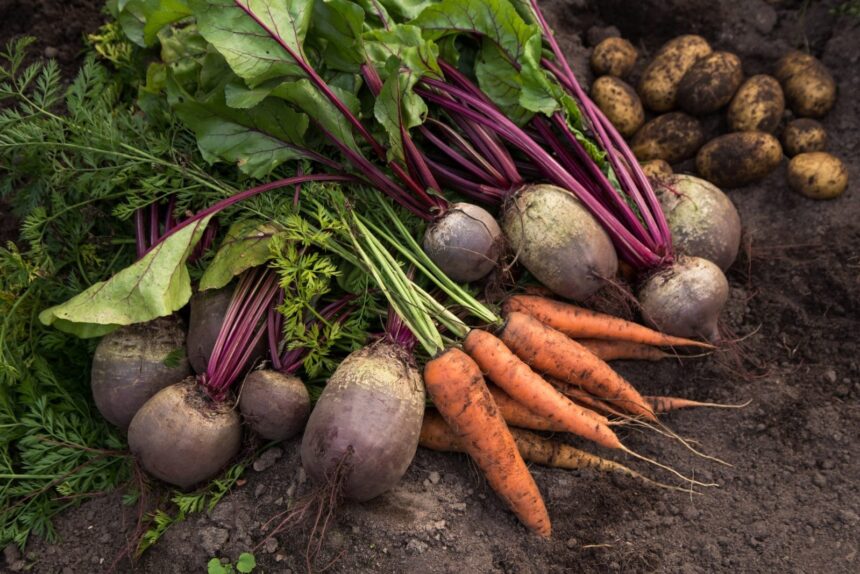
There is a lot of press out there about root vegetables being relatively easy to grow. Potatoes, radishes, beets, carrots, and so on are rumored to pop up quickly and create a beautiful garden with tufts of greenery popping up everywhere. However, that doesn’t always equate to a great harvest.
The thing with root vegetables is that often more greens equate to less root. Like most plants, root vegetables expend a lot of energy and nutrients growing above the ground, and they often will devote these efforts at the expense of what we are really after: big, delicious roots.
They also struggle with other peculiarities. Root vegetables are prone to splitting which makes them less than desirable and less than ideal for storage. They also come with their own set of garden pests, specifically subterranean assassins like gophers and voles.
So, how does one navigate these issues to get some high-quality roots?
Source: Roots and Refuge Farm/YouTube
Nothing But Leaves
Often the problem of getting leaves but no bulbous roots comes down to the soil. Root vegetables are renowned for their ability to mine nutrients from subpar soils, and the roots are where they store energy. Very nitrogen-rich soil will create more greens than roots.
A first step here, if the bed is rich in nitrogen, is to incorporate a bit of sand in the first few inches. Sandy soils generally allow and demand more root growth as opposed to heavy, rich clay soils. Loose soil is much better for growing roots.
Another tip for solving this issue is making sure that the leaves that are there are getting plenty of sunshine but aren’t fighting excessive heat. Even easy-growing radishes won’t thrive in really hot weather, and most other roots are even more into cool weather. It’s best to plant these during the shoulder seasons: spring and fall/late summer.
Root vegetables shouldn’t need fertilizer, and they perform well in the last sequence of the rotational garden. Legumes start the cycle, fixing nitrogen in the soil. Greens follow, devouring the nitrogen. Fruiting veg-like squashes and nightshades come next. Then, when the soil has been sapped a bit, root vegetables come.
Source: The Gardening Channel With James Prigioni/YouTube
Splitting Roots
Another common problem with root vegetables, particularly when the roots are forming, is splitting. Root vegetables will often have large gouges that run longitudinally, making them unattractive and susceptible to disease.
Splitting is typically a result of inconsistent moisture levels, a yo-yo effect of dry conditions and wet conditions, as opposed to the ideal steady availability of water. The inundated roots will grow too quickly and burst. Carrots are particularly prone to this.
Again, this problem is likely solved by looking at the soil. Sand is good for loosening it, and adding in some compost or organic matter can be effective in keeping the soil consistently moist. The compost will capture moisture and keep it available for the roots.
If drought then rain is happening a lot, it might also help to keep the garden watered regularly.
Source: Learn Organic Gardening at GrowingYourGreens/YouTube
Gophers and Ground-Dwellers
Many burrowing animals take advantage of the food that’s where they like to be, and because roots are underground, they might disappear without a gardener ever seeing it coming. Suddenly, that promising crop of root vegetables is gone, greens and all!
The main defense against ground-dwellers is meeting them where they work. Underground fencing, no deeper than a foot, can help to keep them at bay. Raised beds, lifting those roots above ground level, can also provide some relief.
Other deterrents help. A scarecrow with plenty of aroma and noisemakers might scare off burrowers, like voles and groundhogs, that frequent the sunlight. Applying homespun pepper-garlic spray can thwart some taste buds as well, as can simply growing garlic and onion plants around the other roots.
Lastly, pets can help. Using cat litter and roaming dogs will hit the panic buttons within lots of prey animals. They’ll avoid areas where predatory animals seem to be.
Grow, Grow, Grow
Taking these steps will help with a more successful root vegetable harvest. That said, it doesn’t always happen perfectly. One of the great things about most root vegetables is that they provide (or come in packets with) abundant seeds. Plant them like it. Then, thin them out to provide plenty of room for the roots to form.







![Pull Apart Christmas Tree [Vegan] – One Green Planet](https://top-100-recipes.com/wp-content/uploads/2025/12/xscreen-shot-2019-11-29-at-1-57-39-pm-150x150.png.pagespeed.ic.9pB2mNa6N_.jpg)

